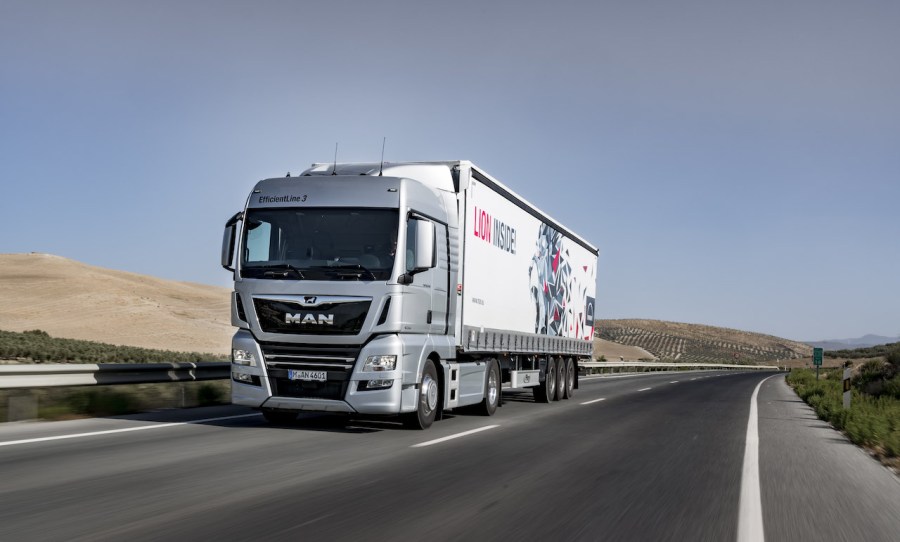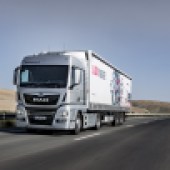Can its latest revised models help the German truck-maker to boost its image among UK operators? We put an MAN TGX and TGM to the test to find out.
While most drivers might aspire to drive a truck ‘from Sweden or the Netherlands’, operators stumping up the cash to buy them may beg to differ – and any savvy haulier will do their homework when looking to acquire new vehicles. Even those who have been brand loyal would be wise to check what else is on the market and undertake a few test drives before they part with their hard-earned cash.
No new truck is cheap, and the purchase price alone of the vehicle can often be misleading. More manufacturers are talking about total life costs which can make a truck with a higher list price more appealing over a three-, four- or five-year period.
It’s fair to say MAN has suffered in recent years from something of an image problem – which is unjust, because the big-cabbed TGX is darn good truck. It’s not perfect (no truck is) and besides, a lot of features are down to the personal preference of the driver or operator.
But for MAN to keep up with its rivals, especially those who have delivered all-new cabs in the last four or five years, means a constant programme of improvements. The TGX looks set to be getting another makeover – new panels and, inevitably, headlights – soon, and there is talk it could be the last such freshen up before a wholly new cab appears, presumably in three or fours years. That, of course, is all speculation, and with the company busy launching its TGE van range, it has had a lot on its plate of late.
In its quest to keep its heavy truck range fresh, the German manufacturer has recently refreshed the interiors of the TGX, TGA, TGM and TGL models for next year and these were shown off to the specialist trade press at a ride and drive event in Spain in early October, giving us the chance to experience some of the new models.
Tractor trip
The first vehicle Trucking took out for a loaded run was an 18.460. Of course, a 6×2 44-tonner 26.460 would have been a better truck for the UK press, but as the majority of attendees were from mainland Europe, the 4×2 truck is more typical. It was, therefore, grossing at 40 tonnes GVW on a five-axle 2+3 combination, But nevertheless, the 460 bhp engine will probably be the best seller for MAN in the UK, so it was still of great interest to see how the truck coped.
The 18.460 is powered by the 12.4-litre, 460 bhp engine and delivers 2300 Nm of torque in the 930-1350 rpm range. It had the middle-of-the-range XLX high-roof cab.
The ride and drive was at Monserrat, near Barcelona and with this area of Spain experiencing a day of strike action, the roads were exceptionally quiet. The route we took the vehicle out was a mix of terrain, with plenty of demanding hills to make the truck work hard. Progress was sedate up those hills; the truck certainly did not fly up them and had to drop down a couple of shifts to keep rolling. But it handled well and was surefooted enough as it tackled the stiff climbs.
For those wanting more power, the latest MANs can be specified with 500, 560 and 640 bhp power outputs. These alternatives are worth considering for longer distances and hiller terrain, especially at 44 tonnes. For much of the UK’s roads, however, then the 460 bhp engine should be fine.
On the road
Leaving the test HQ, the truck was immediately put through its paces by a series of descents and roundabouts, followed immediately by a climb up the slip road to join a dual carriageway which continued uphill, making the truck work hard and at full power.
It was immediately clear the exhaust brake was working well, which will give good peace of mind. The steering was light and precise and the large mirrors afford the driver a good rear view of the trailer. The truck was fully loaded so had to work to its full potential. It wasn’t the quickest, of course, but that is the trade off for having a moderate power level compared with a bigger engine.
But this hilly terrain meant that once we were over the hill, we picked up speed and got a feel for the truck’s cruise control, which was excellent – you can set the speed to what you require to meet traffic and road conditions and the truck will not run away with you. It makes driving more enjoyable as you can concentrate so much more on the road ahead, rather than worrying about keeping to the speed limits.
The responsive steering, and a steering wheel which is a sensible size, also make driving these new trucks very pleasurable indeed.
On the inside
The main changes for those ‘new’ MANs occur inside the cab. MAN has made much better use of the dashboard – making it clearer to use and with more controls closer to the driver based on how often they will most likely be used.
There is also a better use of the internal space. The previous models had an awkward frame that was in front of the bunk, and this has been removed to make using the bunk as a seat or sofa while at rest far easier and more comfortable. It also means it’s easier to get in and out of the lower bunk.
The under-bunk fridge set-up is much better, and whereas before it used to protrude out onto the floor even when stowed away, this is no longer the case. The retractable fridge is an optional extra, and if you do not require it, then you can have a bin for general storage of day-to-day stuff in its place.
The new design is not 100 per cent perfect, and unfortunately the MAN retains the handbrake in a poor location. It really would be better if it was on the dash, like a Volvo or a Scania, but instead the cumbersome arrangement is retained whereby the handbrake lever is in a large box on the floor. This is not only too far back behind the driver’s seat, but also uses up valuable space on what is otherwise a clear, flat floor area. Perhaps it is time for MAN to move to automatic parking brakes?
While the new interior design primarily takes shape around the workplace in the short C and M cabs, drivers will also benefit from a redesign of the living area in the long L, LX, XL, XLX and XXL sleeper cabs, which are mostly used in the MAN TGX and TGS.
The changes inside the cabs include new storage and lighting features as well as the aforementioned new fridge. All the important comfort functions can be controlled via a new operator control concept. In addition, the TGX has an acoustic package that further reduces the noise levels in the cab via extensive insulation measures.
MAN has equipped the new Adaptive Cruise Control variant with a Stop-and-Go function to prevent driver fatigue as far as possible on congested roads and in sluggish traffic situations. This automatically regulates the distance from the vehicle in front (including at low speeds), slows the vehicle (to a stop if necessary) and automatically moves off again after short stops. This way, the driver enjoys less stress, even in stop-and-go traffic.
But we have to be honest and say overall this is a lovely new cab interior, and apart from a couple of (personal) gripes, the interior of the MAN is a match for other makes. It is a pleasant environment and the capacious volume in the cab makes it a great place to spend a week in when on a long-distance haul. And of course, you can always specify the bigger cab – one of the best in the business for interior volume.
Rigid upgrades
As well as showing off the new cab interior on its top-of-the-range heavies, MAN also had improvements to the TGL and TGM rigid ranges to unveil. In the 7.5 to 18 tonnes range, these trucks now have a new range of engines featuring revised power outputs.
The 4.6-litre D0834 four-cylinder is the 160 bhp basic engine with torque upped to 600 Nm. The mid-range version offers 190 bhp and 750 Nm, while the most powerful design provides 220 bhp and 850 Nm. This four-cylinder engine is used exclusively in the MAN TGL, which goes up to 12 tonnes.
The 6.9-litre six-cylinder D0836 is offered in the TGM at 250 bhp with 1050 Nm of torque. The new D08 six-cylinder engine is available in a 290 bhp version with 1150 Nm, as well as a 320 bhp version with 1250 Nm.
The MAN D08SCR engines have a simpler design and exhaust gas after-treatment based solely on Selective Catalytic Reduction (SCR) technology. MAN says this will expand the range of applications while easing maintenance and strengthening overall reliability. The company also claims it has managed to reduce the new engine’s fuel consumption by 5.5 per cent.
The TGL and TGM can also boast added driving comfort and efficiency thanks to new functions for the TipMatic gearbox. Inside the cab, additional upgrades with new controls, has made the trucks more driver-friendly.
The TGM is most likely to be seen in the UK as a 4×2 18-tonner, but is also available as 13-tonne 4×4, a 15-tonne 4×2, an 18-tonne 4×4 and also a 26-tonne 6×2 with a rear-steer tag axle.
Rigid on the road
We took out an 18-tonne 4×2 TGM 18.320 rigid out for a short drive. On the road, and with 320 bhp to boot and loaded at just 15 tonnes GVW, this truck certainly ‘flew’ a bit. Even with three tonnes more on, it would not have made much difference. With power to spare – most 18-tonners are in the 210-250 bhp bracket – this truck was a superb drive. It handled well and accelerated superbly, but then again, it has the power-to-weight equivalent of a 780 bhp truck at 44 tonnes, so it ought to!
UK operators might be more interested in the 250 bhp or 290 bhp versions of this engine for 18-tonne work. The 320, however, would be a great tool for a lightweight, high-volume four-axle drawbar grossing at weights up to 32 tonnes.
Like the artics, the cruise control was easy to use and effective and the truck handled very well. The cab was the standard day cab, but this was a pleasant enough working environment. It’s hard to be overly critical of space in day cabs, as the answer is obvious – if you want more room, specify a sleeper cab. It stands to reason you’ll have less ‘stuff’ with you if you are a day driver, and the TGM has enough room for the kit you’ll typically need every day.
VERDICT
MAN’s new-look trucks are nice enough, and the German company has a good reputation for reliability. Recently they have not been the best for holding their residual value when compared with other makes, but that said, they are not as expensive to buy as some rivals.
Overall, they make a sensible business proposition, and drivers we have spoken to who have MANs tend to like them. The new tweaks to the interior are welcome and you know if you have an MAN TGX, then you have a more than competent tool for any job.
More information: https://www.truck.man.eu/uk








